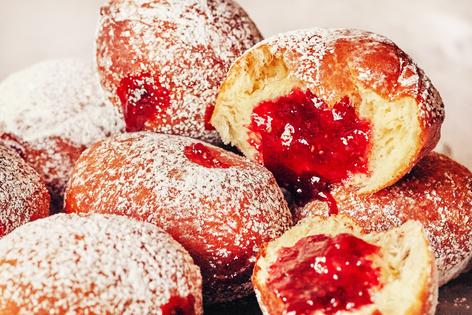The Kitchn: So jelly! Impress your Hanukkah guests with a delicious batch of homemade doughnuts
Sufganiyot are Israeli jelly doughnuts that are common Hanukkah holiday fare. Crisp on the outside, fluffy and tender and bursting with jelly, fresh doughnuts are a divine treat you can make at home when you want to spend an afternoon baking.
Hanukkah and fried food
Fried foods, particularly those fried in olive oil, are traditional for Hanukkah because of the key part oil plays in the holiday story (the Jews were able to recapture their central Temple in Jerusalem, but there was only enough oil to kindle the lights for one day, yet it lasted a miraculous eight days).
For Jews across the globe, fried foods abound this time of year, but the interpretations vary widely. In Eastern Europe and Russia, potato pancakes, or latkes, were common and they have remained holiday fare in the United States over the past century. Latkes are eaten in Israel, but jelly doughnuts, unsurprisingly, steal the show.
What are sufganiyot?
Adding to their holiday significance, these jelly doughnuts have a unique history and offer a look at different ways to make jelly doughnuts. Sufganiyot were likely carried to Israel by immigrant bakers perhaps a century ago. European Jews had no significant tradition of eating sweet fried foods for Hanukkah, but Jews from the Middle East and Mediterranean and other far-flung areas, by and large, ate fried sweets for Hanukkah.
When these traditions came together in Israel, the custom of eating jelly doughnuts evolved and was integrated across all the Jewish cultures there. About four decades ago, American Jews were captivated by the crispy and sweet charms of sufganiyot, and today, sufganiyot are commonly served alongside latkes for the holiday.
Starting with the dough
The dough for these doughnuts is a lot like a bread dough. It will work beautifully in a stand mixer, but not well at all with a handheld electric mixer. If you don't mind using a little elbow grease, you can try kneading this dough by hand, but a stand mixer is your best option.
How to fry doughnuts
Frying enriched doughs can be challenging, even for very experienced cooks. The sugars can caramelize on the outside, making the dough dark before the enriched inside cooks.
There are two things built into this recipe to help you. First, the dough is only partially proofed each time, so it will get the most poof and spring once it hits the heat and will be very light and fluffy inside, so it can cook through with ease.
Second, the heat is a bit lower than most frying recipes; not low enough to be greasy or to absorb a huge amount of oil, but not high enough to over-brown the outside. Now, that does mean that you must be vigilant about the oil temperature and check it constantly and increase or reduce heat as necessary. It's not simple, but it will ensure the best results.
The pot used for this recipe was a coated 6-quart cast iron pot, about 10 inches wide and 5 inches deep, and the oil was about 2 1/2 inches deep. That was enough to fry four doughnuts at a time without any of them touching, and still left plenty of room to turn them. Cast iron holds heat incredibly well and is great for frying. You can use a larger, wider pot, up to 7 1/2 quarts, but make sure you use enough oil to come at least 2 1/2 inches up the side of the pot and that you can fry five at a time.
Filling jelly doughnuts
Some sufganiyot makers fill their doughnuts Berliner-style: two thin discs with a dab of jelly in between. Expert bakers can ace this style, but frankly, I don't go there. The problem is that the discs tend to leak, and if even a little bit of the jelly gets into the hot oil, it will burn and you'll need new oil for subsequent batches, not to mention stopping to deal with hot, now-yucky oil. I make sure that my sufganiyot are all but guaranteed to succeed. I fill a pastry bag with jelly, poke the doughnuts with its sharp tip, and squeeze the jelly into the fried doughnut. Making sufganiyot simply works better with this less-traditional technique.
Jelly Doughnuts (Sufganiyot)
Makes 22 doughnuts
1/2 cup warm water (between 90 F and 100 F)
2 (1/4-ounce) packets instant or active dry yeast (4 1/2 teaspoons)
6 1/2 cups all-purpose flour, plus more for dusting
1/2 cup plus 1 tablespoon granulated sugar
1 teaspoon salt
1 1/2 cups whole milk, at room temperature
4 tablespoons unsalted butter, melted, or 1/4 cup mild-flavored oil
1 teaspoon vanilla extract
Finely grated zest of 1/2 medium lemon
3 large eggs, lightly beaten
8 cups peanut, avocado, or canola oil
Cooking spray
1 cup seedless red berry jelly, such as strawberry or raspberry
1/3 cup powdered sugar
1. Proof the yeast. Place the water and yeast in the bowl of a stand mixer fitted with the paddle attachment. Mix on low speed just until combined, 3 or 4 turns. Let sit until it is bubbly, foamy and smells strongly of yeast, 5 to 7 minutes.
2. Mix the dry ingredients. Place the flour, sugar and salt in very large bowl, and whisk until combined; set aside.
3. Add the milk, melted butter or oil, vanilla, and zest to the yeast, and mix on medium speed until fully combined.
4. Add the eggs, and mix on low speed until fully combined, about 1 minute.
5. Add the dry ingredients. Add the flour mixture on low speed, 1 to 1 1/2 cups at a time, increasing the speed to medium and mixing until fully combined before adding more of the flour mixture back on low speed. After the first 3 cups have been added or when the dough no longer mixes with ease, switch the paddle to the dough hook. Stop the mixer as needed to scrape the bottom and sides of the mixer bowl with a rubber spatula.
6. Knead the dough on low to medium-low speed until shiny, very smooth, soft but not mushy, and noticeably elastic, 6 to 7 minutes. This is a tacky dough, and it will wrap around the dough hook and clear the side of the mixer bowl, but it will stick to the bottom.
7. Rise and rest the dough. Transfer the dough to a clean, very large bowl. Cover lightly with plastic wrap and a kitchen towel. Refrigerate for 2 to 2 1/2 hours. It will increase in size to almost 1 1/2 times the original volume. This is a slow and partial rise that will allow the dough enough time to rest.
8. Get ready to roll the dough. Line two rimmed baking sheets with parchment paper. Dust a work surface and rolling pin lightly with flour and scoop the dough onto the work surface. After chilling, the dough will no longer feel tacky, but soft, supple and easy to handle.
9. Roll and cut the dough. Divide the dough into two portions, each about 30 ounces. Wrap one portion in plastic wrap and refrigerate. Roll out the other about 3/4-inch thick. Dip a 3- to 3 1/4-inch round cookie cutter or 3-inch-wide drinking glass into some flour, and cut out 8 rounds. Place the remaining dough in a resealable plastic bag, seal and refrigerate.
10. Rise the dough again. Dust any excess flour off the doughnuts with a pastry brush. Spray a flat spatula with cooking spray, and use it to transfer the dough rounds to the prepared baking sheets. Handling the cut doughnuts without stretching can be tricky, but if they are slightly misshapen, re-form them into rounds on the baking sheet. Cover with clean kitchen towels and allow to rise until they expand about 25 percent, about 15 minutes.
11. Set up the frying area. Pour 8 cups of the oil into a deep, wide 6-quart Dutch oven. The oil should be at least 2 1/2 inches deep and no more than halfway up the side. Fit a deep-fry thermometer in the oil, making sure it does not touch the bottom of the pot. If you are using an instant-read thermometer, position it up near the stovetop. Line a heat-resistant platter or another baking sheet with paper towels and set it near the stove. Have a kitchen spider or a heat-resistant slotted spoon ready. Set a cooling rack over more paper towels in the work area. Heat the oil over medium heat until it reaches 355 F to 360 F. Adjust the heat as needed during frying to stay within this temperature range.
12. Fry the doughnuts. Using the spider or slotted spoon, gently place 4 doughnuts, one at a time, into the oil, being careful not to splatter the hot oil and making sure they don't touch each other. If the temperature drops below 350 F, turn the heat up quickly to get it back between 355 F and 360 F. The doughnuts will begin to expand as soon as they touch the oil. When they are golden-brown, after about 1 1/2 to 2 minutes, carefully turn them with the spider or slotted spoon, and fry the second side, about 1 1/2 to 2 minutes, until they are deep golden-brown on the other side, crisp on the outside, and cooked through. With the spider or slotted spoon, carefully transfer the doughnuts to the towel-lined platter. Gently place the remaining 4 doughnuts into the oil and repeat the frying process. When the first 4 doughnuts are cool enough to touch, transfer them to the cooling rack. When the second batch is fried, transfer to the towel-lined platter to cool. Turn the heat off from under the oil. Let the first batch of doughnuts cool completely, at least 30 minutes.
13. Repeat making more doughnuts. Roll and cut the second piece of dough, saving the excess in the same plastic bag in the refrigerator as the first batch. Repeat rising and frying the second batch. Turn the heat off after frying the last doughnut.
14. Use the scraps for 1 more batch. Dust the work surface lightly with flour again. Place the refrigerated scraps from the first two batches on the work surface and knead together, about 1 minute. Cover the dough with a kitchen towel and allow to rest for 3 minutes while you reheat the oil to 355 F to 360 F. Dust the rolling pin with flour again, roll the dough 3/4-inch thick, and cut 4 more doughnuts. (There will be a little bit of dough left, which would be great for doughnut hole treats for the "chef.") Allow to rise for 15 minutes. Fry, drain and cool. Keep the batches separate so you can easily fill the ones that have cooled while the others are still cooling.
15. Fill the doughnuts. Transfer the jelly into a pastry bag fitted with a small, sharp tip or a squeeze bottle with small, firm tip. Insert the tip into the side of one of the cooled doughnuts and squeeze for 2 to 3 seconds, or until you see a small dab of jelly at the point of entry. Place the filled doughnut back on the cooling rack or on a clean plate and repeat with all of the doughnuts, working with the second and third batches only after they have cooled.
16. Liberally dust the filled doughnuts with powdered sugar before serving.
Recipe notes: These homemade doughnuts are best eaten within about two hours of frying, but they will keep and be fresh for about eight hours.
(Tami Weiser is a contributor to TheKitchn.com, a nationally known blog for people who love food and home cooking. Submit any comments or questions to editorial@thekitchn.com.)







